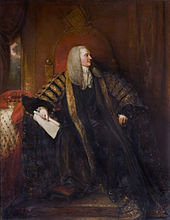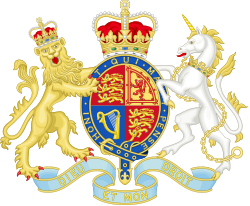William Cavendish-Bentinck, 3. Duke of Portland



William Henry Cavendish-Bentinck, 3. Duke of Portland (* 14. April 1738 in Nottinghamshire; † 30. Oktober 1809 in Bulstrode, Buckinghamshire), war ein britischer Politiker der Whigs und der Tories und 1783 sowie von 1807 bis 1809 Premierminister.
Leben
Er wurde mit dem Namen William Henry Bentinck als ältester Sohn von William Bentinck, 2. Duke of Portland und Margaret Harley geboren. Als Heir apparent seines Vaters führte er bis 1762 den Höflichkeitstitel Marquess of Titchfield. Später ergänzte er seinen Familiennamen mit Royal Licence vom 5. Oktober 1801 zu Cavendish-Bentinck und ergänzte sein Wappen um das jener Familie.
Er wurde an der Westminster School erzogen und schloss 1757 sein Studium am Christ Church College der University of Oxford als Master of Arts ab. 1761 wurde er als Abgeordneter für das Borough Weobley in Herefordshire ins House of Commons gewählt. Ein Jahr später zog er ins House of Lords ein, nachdem er beim Tod seines Vaters dessen Adelstitel als Duke of Portland geerbt hatte. Er stand der aristokratischen Whig-Partei von Charles Watson-Wentworth, 2. Marquess of Rockingham, nahe. So diente er in dessen erster Regierung (1765–1766) als Lord Chamberlain of the Household und danach, in Rockinghams zweiter Amtszeit (April–August 1782), als Lord Lieutenant of Ireland. Nach Rockinghams Tod gehörte er Regierung von William Petty, 2. Earl of Shelburne, nicht mehr an, da er ein Anhänger von Charles James Fox war.
Im April 1783 kam Bentinck als nomineller Kopf einer Koalitionsregierung ins Rampenlicht. Deren wahre Führer waren jedoch James Fox und Lord North. Er gehörte dieser Regierung als Lord of the Treasury an, bis sie im Dezember desselben Jahres zerfiel.
Wie viele andere konservative Whigs (unter ihnen Edmund Burke) empfand der Duke ein tiefes Unbehagen über die Französische Revolution. Er zerstritt sich mit Fox wegen dieses Problems und schloss sich 1794 Pitts Regierung als Innenminister an. Er gehörte dem Kabinett bis zu Pitts Tod 1806 an – von 1801 bis 1805 als Lord President of the Council, danach als Minister ohne Geschäftsbereich.
1794 wurde er in den Hosenbandorden aufgenommen.
Als Pitts Anhänger nach dem Sturz der „Regierung aller Talente“ im März 1807 wieder an die Macht kamen, war Bentinck wieder eine akzeptable Galionsfigur für eine zänkische Gruppe von Ministern wie George Canning, Lord Castlereagh, Lord Hawkesbury und Spencer Perceval.
Cavendish-Bentincks zweite Regierung erlebte die vollständige Isolation des Vereinigten Königreichs vom Kontinent (Kontinentalsperre durch Napoleon), aber auch den Anfang der Erholung, als der Spanische Befreiungskrieg begann. Im Herbst 1809 trat der Duke wegen seines schlechten Gesundheitszustands und wegen des skandalösen Duells zwischen Canning und Castlereagh zurück. Kurz darauf starb er.
Trivia
Die Portlandvase ist nach seiner Familie benannt, der sie zeitweise gehörte.
Ehe und Nachkommen

Cavendish-Bentinck heiratete 1766 Lady Dorothy Cavendish (1750–1794), eine Tochter von William Cavendish, 4. Duke of Devonshire. Das Ehepaar hatte folgende Kinder:
- William Cavendish-Scott-Bentinck, 4. Duke of Portland (1768–1854)
- Lady Charlotte Cavendish-Bentinck (1773–1862) ⚭ 1793 Charles Greville
- Lord William Henry Cavendish-Bentinck (1774–1839)
- Lord William Charles Cavendish-Bentinck (1780–1826) ⚭ (1) 1808 Georgiana Seymour, ⚭ (2) 1816 Lady Anne Wellesley, Tochter des Richard Wellesley, 1. Marquess Wellesley
- Lord Frederick Cavendish-Bentinck (1781–1828) ⚭ 1820 Lady Mary Lowther, Tochter des William Lowther, 1. Earl of Lonsdale
Literatur
- H.C.G. Matthew: Bentinck, William Henry Cavendish. In: Leslie Stephen (Hrsg.): Dictionary of National Biography. Band 4: Beal – Biber. MacMillan & Co, Smith, Elder & Co., New York City / London 1885, S. 302–304 (englisch, Volltext [Wikisource]).
- V. Söderberg: Bentinck – 2. William Henry Cavendish-B. In: Bernhard Meijer (Hrsg.): Nordisk familjebok konversationslexikon och realencyklopedi. 2. Auflage. Band 2: Armatoler–Bergsund. Nordisk familjeboks förlag, Stockholm 1904, Sp. 1380–1381 (schwedisch, runeberg.org – Familienartikel).
- Dick Leonard: William Henry Cavendish-Bentinck, third Duke of Portland: Twice a figurehead Premier. In: ders.: British Prime Ministers from Walpole to Salisbury. The 18th and 19th centuries, Bd. 1, Routledge, London 2021, ISBN 978-0-367-46911-5, S. 145–153.
Weblinks
- William Henry Cavendish-Bentinck, 3rd Duke of Portland auf thepeerage.com
| Vorgänger | Amt | Nachfolger |
|---|---|---|
| William Bentinck | Duke of Portland 1762–1809 | William Cavendish-Scott-Bentinck |
| Granville Leveson-Gower | Lord Chamberlain 1765–1766 | Francis Seymour-Conway |
| Frederick Howard | Lord Lieutenant of Ireland 1782 | George Nugent-Temple-Grenville |
| Henry Dundas | Home Secretary 1794–1801 | Thomas Pelham |
| John Pitt | Lord President of the Council 1801–1805 | Henry Addington |
| Personendaten | |
|---|---|
| NAME | Cavendish-Bentinck, William, 3. Duke of Portland |
| ALTERNATIVNAMEN | Cavendish-Bentinck, William Henry, 3. Duke of Portland; Bentinck, William, Marquess of Titchfield |
| KURZBESCHREIBUNG | britischer Politiker und Premierminister |
| GEBURTSDATUM | 14. April 1738 |
| GEBURTSORT | Nottinghamshire |
| STERBEDATUM | 30. Oktober 1809 |
| STERBEORT | Bulstrode, Buckinghamshire |
Auf dieser Seite verwendete Medien
Autor/Urheber: Sodacan, Lizenz: CC BY-SA 3.0
Royal Coat of Arms of the United Kingdom of Great Britain and Northern Ireland in the style used by the Government of Queen Elizabeth II from 1952 to 2022 (as used in all places except Scotland).
| “ | Quarterly, First and Fourth Gules three lions passant guardant in pale Or armed and langued Azure (for England), Second quarter Or a lion rampant within a double tressure flory counter-flory Gules (for Scotland), Third quarter Azure a harp Or stringed Argent (for Ireland), the whole surrounded by the Garter; for a Crest, the imperial crown Proper; for Supporters, dexter a lion rampant guardant Or crowned as the Crest, sinister a unicorn Argent armed, crined and unguled Proper, gorged with a coronet Or composed of crosses patée and fleurs de lys a chain affixed thereto passing between the forelegs and reflexed over the back also Or; Motto 'Dieu et mon Droit’ ('God and my Right') below the shield. | ” |
- PINCHES, J.H & R.V., The Royal Heraldry of England, 1974, Heraldry Today.
Autor/Urheber: Sodacan, Lizenz: CC BY-SA 3.0
Royal Coat of Arms of the United Kingdom of Great Britain and Northern Ireland in the style used by the Government of Queen Elizabeth II from 1952 to 2022 (as used in all places except Scotland).
| “ | Quarterly, First and Fourth Gules three lions passant guardant in pale Or armed and langued Azure (for England), Second quarter Or a lion rampant within a double tressure flory counter-flory Gules (for Scotland), Third quarter Azure a harp Or stringed Argent (for Ireland), the whole surrounded by the Garter; for a Crest, the imperial crown Proper; for Supporters, dexter a lion rampant guardant Or crowned as the Crest, sinister a unicorn Argent armed, crined and unguled Proper, gorged with a coronet Or composed of crosses patée and fleurs de lys a chain affixed thereto passing between the forelegs and reflexed over the back also Or; Motto 'Dieu et mon Droit’ ('God and my Right') below the shield. | ” |
- PINCHES, J.H & R.V., The Royal Heraldry of England, 1974, Heraldry Today.
A three-quarter-length portrait of William Cavendish-Bentinck, 3rd Duke of Portland, turned to the left, gazing to the left, seated in a red upholstered armchair, holding some papers with his left hand and his cheek leaning on his right hand. Dressed in dark crimson velvet coat and knee-breeches, with white stockings, Short powdered wig, tied at the back with a black ribbon. Architectural background with pillard portico on the left, with view of trees and sky. On the
table are books, and two bronze statuettes, one representing either Samson or Hercules holding the jawbone of an ass, the other possibly a boxer.Dorothy Cavendish was daughter of William Cavendish, 4th Duke of Devonshire and wife of William Cavendish-Bentinck, 3rd Duke of Portland (1738-1809)
Autor/Urheber: Varavour, Lizenz: CC BY-SA 4.0
Coat of Arms of the Dukes of Portland (adopted in 1802 after their name became Cavendish-Bentinck)
Blason:
Arms: Quarterly: 1st and 4th, Azure a cross moline Argent (Bentinck); 2nd and 3rd, Sable three stags' heads cabossed Argent attired Or, a crescent for difference (Cavendish)
1st Crest: Out of a ducal coronet proper two arms counter-embowed vested Gules, on the hands gloves Or, each holding an ostrich feather Argent (Bentinck)
2nd Crest: A snake nowed proper (Cavendish)
Supporters: Two lions double queued, the dexter Or and the sinister sable



